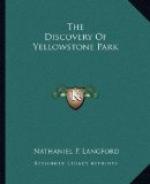Ever since the first year of my residence there I had frequently heard rumors of the existence of wonderful phenomena in the region where the Yellowstone, Wind, Snake and other large rivers take their rise, and as often had determined to improve the first opportunity to visit and explore it, but had been deterred by the presence of unusual and insurmountable dangers. It was at that time inhabited only by wild beasts and roving bands of hostile Indians. An occasional trapper or old mountaineer were the only white persons who had ever seen even those portions of it nearest to civilization, previous to the visit of David E. Folsom and C.W. Cook in the year 1869. Of these some had seen one, some another object of interest; but as they were all believed to be romancers their stories were received with great distrust.
[Illustration: James Bridger.]
The old mountaineers of Montana were generally regarded as great fabricators. I have met with many, but never one who was not fond of practicing upon the credulity of those who listened to the recital of his adventures. James Bridger, the discoverer of Great Salt lake, who had a large experience in wild mountain life, wove so much of romance around his Indian adventures that his narrations were generally received with many grains of allowance by his listeners. Probably no man ever had a more varied and interesting experience during a long period of sojourning on the western plains and in the Rocky Mountains than Bridger, and he did not hesitate, if a favorable occasion offered, to “guy” the unsophisticated. At one time when in camp near “Pumpkin Butte,” a well-known landmark near Fort Laramie, rising a thousand feet or more above the surrounding plain, a young attache of the party approached Mr. Bridger, and in a rather patronizing manner said: “Mr. Bridger, they tell me that you have lived a long time on these plains and in the mountains.” Mr. Bridger, pointing toward “Pumpkin Butte,” replied: “Young man, you see that butte over there! Well, that mountain was a hole in the ground when I came here.”
Bridger’s long sojourn in the Rocky Mountains commenced as early as the year 1820, and in 1832 we find him a resident partner in the Rocky Mountain Fur Company. He frequently spent periods of time varying from three months to two years, so far removed from any settlement or trading post, that neither flour nor bread stuffs in any form could be obtained, the only available substitute for bread being the various roots found in the Rocky Mountain region.
I first became acquainted with Bridger in the year 1866. He was then employed by a wagon road company, of which I was president, to conduct the emigration from the states to Montana, by way of Fort Laramie, the Big Horn river and Emigrant gulch. He told me in Virginia City, Mont., at that time, of the existence of hot spouting springs in the vicinity of the source of the Yellowstone and Madison rivers, and said that




